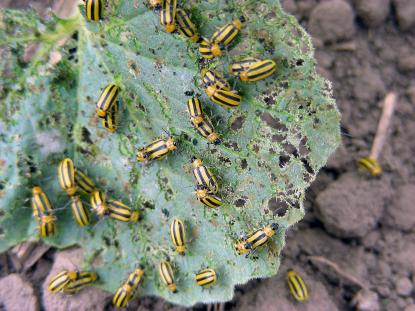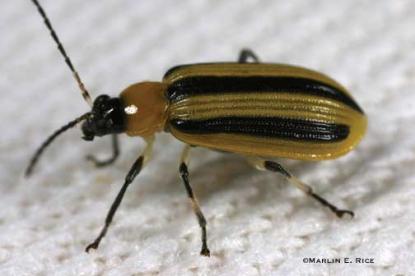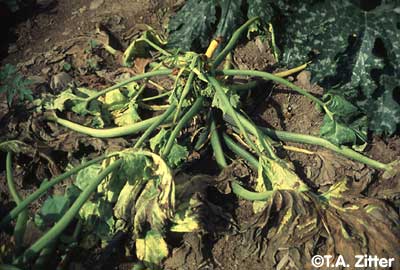Today I’m writing about evil. Not just bad, like glass used for paving a bike path. Not just wrong like Michelle Bachmann’s opinions, but evil. Evil like, well like Dick Cheney.
Tuesday morning before the smallish organisms that inhabit my house had begun demanding food or coffee (pop, pop, pop, meow, meow, meow, cluck, cluck, cluck, did YOU MAKE THE COFFEE yet Mr. Freaking sunshine?), I ambled out to the garden intent on planting some more beans and lettuce. But what to my horrified eyes should appear but:

That’s right terrified reader. The striped cucumber beetle had arrived! I had removed the floating row covers from my zucchini a few days earlier. (Despite it’s name, the SCB will eat any squash family plant though they like cucumbers and zucchini best (at least in my experience)). From far far across the yard the slumbering cucumber beetle nestled in its woody debris for the winter smelled the lovely cucurbitacin wafting through the air. The temperature was right (>65 Fahrenheit, thanks for asking) and so they attacked.
Here’s a close up. Note yellow wings, black stripes and little yellow flirty splashes on the legs.

Grr. Sure they make ugly holes in the plants, but the really irritating thing that striped cucumber beetles do is they spread bacterial wilt. They carry it around in their filthy little guts and after they eat my plants the bacteria come out in their frass (that’s bug poop). The bacteria then move from the frass into the wounds created by said cucumber beetles. As bacteria are inclined to do, they begin to multiply.

In case you’re wondering the death phase for bacteria happens in enlosed flasks. If you wish to harvest bacteria for any reason, you want to get it at the exponential growth phase. It’s always good to know these things.

As their population hits high numbers they block up the xylem. Xylem conducts water so once this happens the plants lose turgor and wilt. Then they look gross.

As a defense I tend to plant a little late and use floating row covers (as mentioned earlier). But I had been foiled. Now I had to kill them before they worked their other diabolical trick. The little beasts eat and eat and eat then go hide under the lower leaves of the plant and do their naughty business (at least it’s in private). Once finished the ladies lay eggs around the stem of the plant. In about a week the larvae hatch and begin eating the roots of your plant. What?! leaves, bacteria, now roots? Are they unable to curb their rapacious ways? Apparently they are not: once the plants flower (if they make it that long) the beetles begin eating the flowers and pollen (so no fruit)!
A month and a half later the larvae pupate with a full stomach of cucurbit roots then emerge not as beautiful butterflies but as evil little Dick Cheney heads (Ok that’s not true they’re still beetles) and do it all over again. In MA we can have two generations before the adults go and hide themselves in woody debris for the winter.
There is only one good thing about striped cucumber beetles. They make a very satisfying crunch when you mush them and they barely smell at all unlike squash bugs.
For more information:
http://www.vegedge.umn.edu/vegpest/CUCS/scb.htm
https://attra.ncat.org/attra-pub/cucumberbeetle.html
infestation from
http://www.vegedge.umn.edu/MNFruit&VegNews/vol5/711veg.htm
close up from
http://www.ipm.iastate.edu/ipm/icm/node/461
bac wilt from
http://vegetablemdonline.ppath.cornell.edu/DiagnosticKeys/CucurWlt/BctWlt/BctWlt_SmrSq.htm
bacteria from
http://vegetablemdonline.ppath.cornell.edu/DiagnosticKeys/CucurWlt/BctWlt/BctWlt_SmrSq.htm


